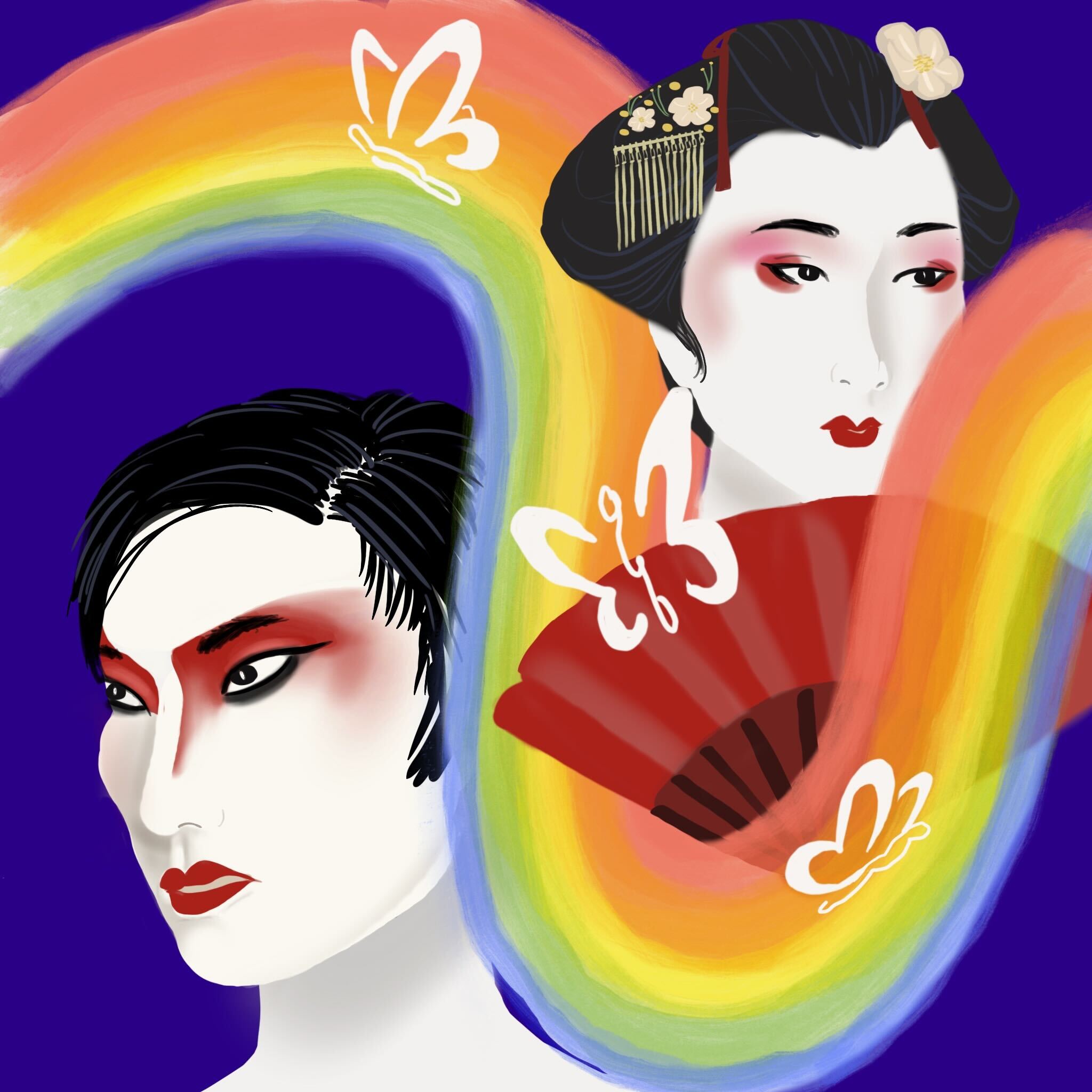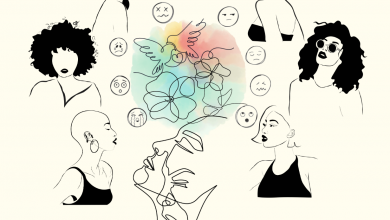Butterfly: The Orientalist Queer Critique

Design by Cassandra Sanchez
Image description: Illustration of ‘Butterfly’ figures from Puccini’s Opera and Hwong’s Play on a dark blue background. A rainbow wave with white butterflies on it separates the two figures.
CW: SA, suicide, gender dysphoria
Butterfly: a beautiful, exotic, delicate, docile, innocent, sexual, and submissive East Asian “woman”. She’s everything a man could desire in a wife.
Spoiler alert: she’s a man.
In the 1903 opera “Madame Butterfly” by Giacomo Puccini (based on the 1898 short novel by John Luther Long), U.S. naval officer Pinkerton marries a 15-year-old girl, Cio-cio-san (meaning “butterfly”) in Nagasaki, Japan. Pinkerton intends to marry “Butterfly” while he is stationed in Japan and divorce her when he returns to America and finds a “proper” wife. Butterfly, young and innocent, is so excited to marry an American man that she converts to Christianity and pines after him, refusing to remarry for three years even after he returns to America.
Pinkerton eventually returns to Japan, bringing with him his “real” wife: a white American woman named Kate. After learning that her years of unrequited love for Pinkerton were in vain, Butterfly performs a ritual “sacrifice” as she stabs herself with a ceremonial knife at the feet of her ancestral statues. Pinkerton rushes in, but is too late to save her, and she dies.
For modern viewers, “Madame Butterfly” may seem like a fictional story representing a racist past. However, its themes of Orientalism, sexualization of East Asian women, and domination are still ever-present in our society today.
Orientalism, as defined by author Edward Said, is the idea that there is an essential cultural difference between the “East” and the “West,” where the “West” occupies a hierarchical position of superiority and the “East” occupies a hierarchical position of inferiority, which means that the exotic fetishization of East Asian women and girls is a racialized, gendered, geographical and imperialist concept.
Pinkerton arrives on stage and “The Star-Spangled Banner” plays, becoming his “theme” for the rest of the opera. His image is associated with excellence, strength, masculinity, and most importantly, superiority. In contrast, Butterfly is docile, weak, feminine and inferior. She is characterized as vulnerable and completely submissive to the desires of Pinkerton, making her sexuality and gender a performance of “Western” ideals. Pinkerton is infatuated with this “perfect” Asian bride, making her position as a child bride even more vulnerable as he says in the opera that he “must have her, even though I injure her butterfly wings.” Butterfly, on the other hand, is obsessed with her American marriage and actively rejects her former religious and cultural traditions in favor of worshiping the “American” Christian God and, in turn, her American husband.
Because Madame Butterfly is a story of white, heterosexual, cisgender, male domination, it is also a story that reflects the reality of sexual violence against Asian women. In Madame Butterfly, Pinkerton represents the “West” and Butterfly represents the “East” where, according to author Dorienne Kondo, the “West believes the East, deep down, wants to be dominated.” In doing so, the opera enacts a gendered and violent trope, playing into both explicit and implicit forms of sexual violence. In Madame Butterfly, we see Butterfly, a fifteen year old girl, not only raped and coerced into child marriage, but shown to enjoy it, making her a victim/survivor of her experience and a passive agent in her own story. In the mindset of the colonizer, the idea that the “colonized” have a receptiveness to violence, imperialism, and the forced imposition of new cultural practices and values, justifies the conquest of the “East” by the “West.”
In a story about colonization, hierarchy, gender-based violence, and rape, is there any space for Butterfly to exert agency? Asian-American playwright David Henry Hwong flips the script with “M. Butterfly,” a satirical play (and subsequent film) in response to “Madame Butterfly.” In this critique, we see similar themes of a “Western” man falling for a “perfectly exotic” Asian bride, with a major twist: Liling Song’s “Butterfly” is a Chinese opera singer, and her character is played by a man.
Our protagonist, René Gallimard, is a French man, and therefore unaware that in traditional Beijing opera, female characters are portrayed by men in costume. During the twenty years that Gallimard and Song are married, Song maintains the mystique and femininity of his “Butterfly” character, even during intimate moments between the two. Eventually, the truth comes out and Song is revealed to be a man spying on Gallimard for the Chinese government. Unable to live with the truth that his “perfect woman” was actually a man, Gallimard retreats into his memories, dons the wig and costume of the Butterfly character, and kills himself.
“M. Butterfly” is both a critique of the original “Madame Butterfly” and of new themes of gender and sexuality beyond the socially constructed binaries. As a man cross-dressing like a woman, Hwong takes care to emphasize that Song’s story is not meant to represent trans people or non-binary identities, as Song is just a man pretending to be a woman for an ulterior motive. Rather, Song’s performance of Butterfly is a reflection of how gender is just that—a performance—made possible because, as Hwong writes in the play, “only a man knows how a woman is supposed to act.” Gendered performances, rooted in Orientalism, also defined Gallimard’s masculinity. In his love for Song, Gallimard became the “real man:” a white man with a fascination for a delicate Asian bride, dominance to her submission and violence to her passivity. Thus, the “West”’s imagined creation of the “East” has the power to shape the “West” only in contrast to idealized forms of masculinity and whiteness in Hwong’s narrative, as the two concepts are definitionally tied to one another.
As to Gallimard’s own sexuality, whether he knew about Song’s deception is up to interpretation. I like to think that his forbidden relationship with his Butterfly was simply a signification of the “Western” man’s own delusions, and fear towards confronting his real sexuality. Because of Song’s changing and fluid gender presentations, the labels of “gay” and “straight” don’t perfectly apply to Gallimard. At times, we may think “there’s no way that Gallimard didn’t realize Song was a man for twenty years,” but perhaps, Gallimard knew the “Butterfly” that he saw in Song was a performance, not reality. Perhaps he allowed himself to be deceived.
“M. Butterfly” blurs the lines between reality and performance, love and infatuation, gender and sexuality, and “East” and “West.” At the end of the day, it becomes difficult to articulate how Butterfly from “Madame Butterfly” and Song’s feminine-presenting Butterfly from “M. Butterfly” are more different than they are similar. As gender isn’t based solely on biological characteristics, can we even consider Song’s performance of a woman made to appeal to the “Western” man to be any different than the hypersexual and fragile Butterfly from the original story?
In my view, “Madame Butterfly” raises these questions of gender as being related to domination and imperialism, but ultimately victimizes the “East” in its portrayal of the “sacrificial” suicide of the innocent Butterfly at the end of its third act. However, it is Gallimard, the white man, who tragically takes his own life at the end of Hwong’s adaptation in fear of further confronting his questioning/queer identity.
The underlying thread between these two stories is the Orientalist perception of femininity as “weak” and masculinity as “dominant.” In “Madame Butterfly,”, the feminine character kills herself in a display of “sacrifice” and a submission to “Western” ideals of East Asian women. However, this narrative is not completely flipped in Hwong’s “M. Butterfly.” Even though it is Gallimard who commits suicide at the end of the play, he does so after donning Song’s previous Butterfly costume and wig. Song’s Butterfly performed femininity on a superficial level, which was enough to “deceive” Gallimard, who is terrified to confront his queerness and femininity after discovering he has fallen in love with a man. In the end, Gallimard dies by suicide, so femininity and its performance is the true killer in both stories.
While neither “Madame Butterfly” or “M. Butterfly”’s representations of Orientalism are perfect, they build into the complex narrative of what it means to be Asian or Asian American in a world of intersecting racialized, gendered, and imperialist violence. These themes of Orientalism, queerphobia, and sexism translate into modern-day anti-Asian violence in America, marked by a rise in hate crimes, particularly those against Asian American women, during the COVID-19 pandemic.
In particular, both Butterfly characters captured the essence of fetishization of East Asian women by white men, giving rise to violence like the Atlanta spa shootings of spring 2021 that killed eight people, six of whom were Asian women, in a racially motivated attack against some of the most vulnerable populations in America. The shooter, a white man, claimed he was “eliminating temptation” because of a “sexual addiction” he had to Asian women. In doing so, this white man used violence to eliminate the complexity, depth, and individuality of these Asian women, something the “West” has been doing to the “East” for generations.
Asian women are so much more than sex, submission, and femininity. Orientalism forcibly removes their agency as complex and human characters in their own stories, with layers and personalities that aren’t contextualized to “Western” civilization. While it may be difficult to separate our perceptions of the “East” from the real lives of Asian women, my critique (and in general, life philosophy) boils down very simply.
Let Asian women live.




